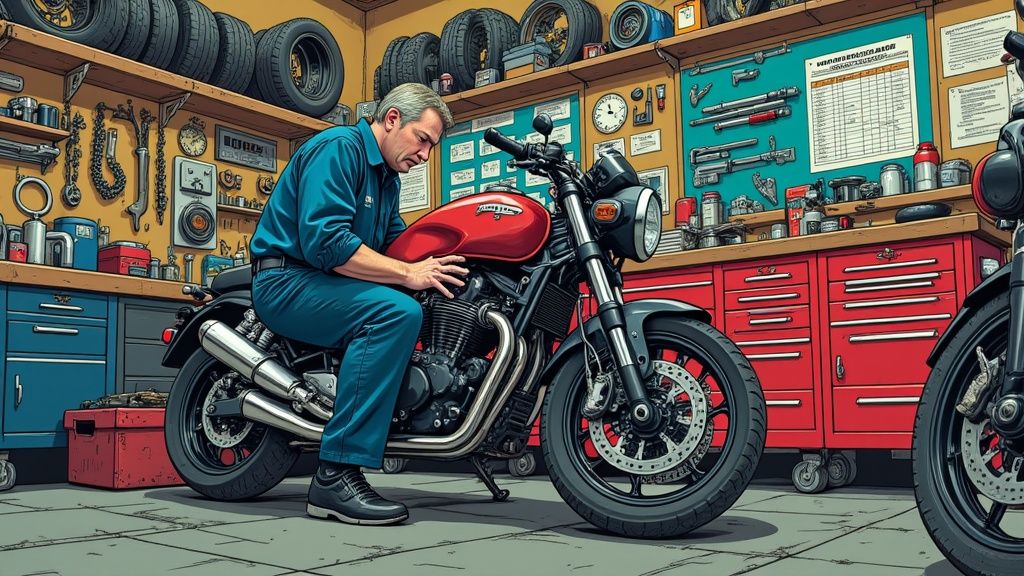
Essential Motorcycle Maintenance Tips: Guide to Expert Care and Peak Performance
Building Your Motorcycle Maintenance Strategy
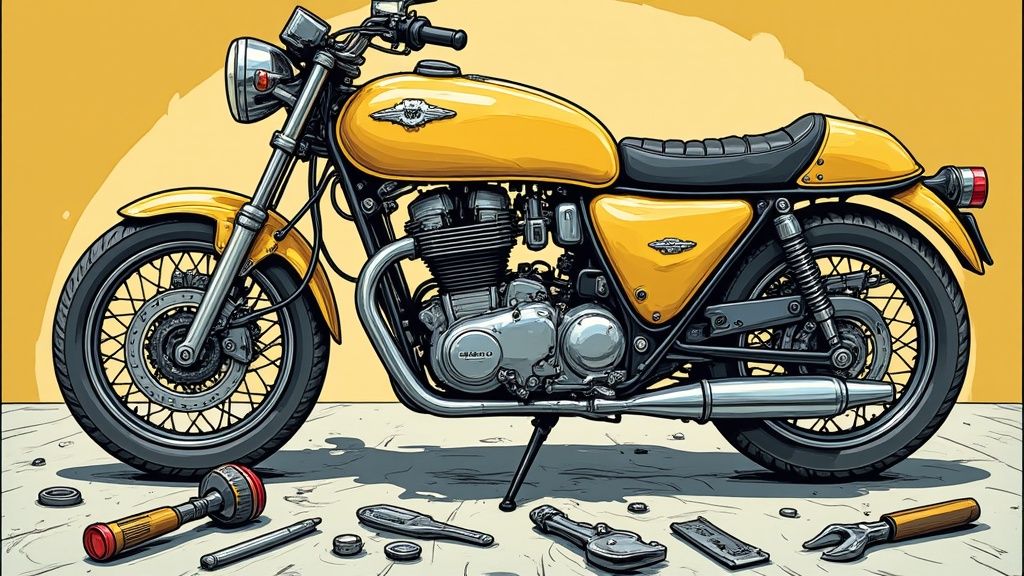
A properly maintained motorcycle delivers better performance, safety, and durability. Creating an effective maintenance plan goes beyond basic inspections - it requires developing systems and habits specifically matched to your bike and how you ride. When done right, good maintenance keeps your motorcycle running at its best mile after mile.
Understanding Your Motorcycle’s Needs
Each motorcycle has its own unique maintenance requirements based on its design and usage. Start by thoroughly reading your owner’s manual, which provides the manufacturer’s recommended service schedules and procedures. For example, if you ride a high-performance sportbike aggressively, you’ll need more frequent maintenance compared to someone taking casual weekend cruises. Environmental factors also matter - dusty roads or wet conditions mean cleaning and lubricating parts more often to prevent premature wear.
Creating a Sustainable Maintenance Routine
The key to motorcycle maintenance success is establishing consistent habits that fit your schedule. This could mean blocking off one weekend each month for major service or doing quick pre-ride checks before hitting the road. Many riders find it helpful to track their maintenance using a simple logbook or digital tool like Auto Service Logger, which helps monitor mileage, store records, and generate service reports. Regular logging makes it easier to stay on top of oil changes and other critical tasks while catching potential issues early before they become expensive problems.
Prioritizing Key Service Intervals
While following the manufacturer’s maintenance schedule is essential, certain service items deserve special attention. Engine oil changes are critical since oil breaks down over time, reducing engine protection. Most bikes need oil changes every 3,000-5,000 miles, though hard riding conditions may require more frequent changes. Tire maintenance is equally important since tires directly affect safety and handling. Just like shoes, tires need proper inflation and tread depth to grip the road effectively. Under-inflated or worn tires significantly reduce braking and cornering performance.
Adapting to Different Riding Conditions
A good maintenance strategy evolves based on how and where you ride. Changes in mileage, temperature extremes, or terrain types all impact service needs. For instance, frequent riding on dusty back roads means cleaning or replacing air filters more often to protect your engine from debris. By adjusting maintenance to match real-world conditions while following these core principles, you’ll extend your motorcycle’s lifespan and get more enjoyment from every ride. The key is being proactive and responsive to your bike’s changing needs over time.
Mastering Essential Fluid Management
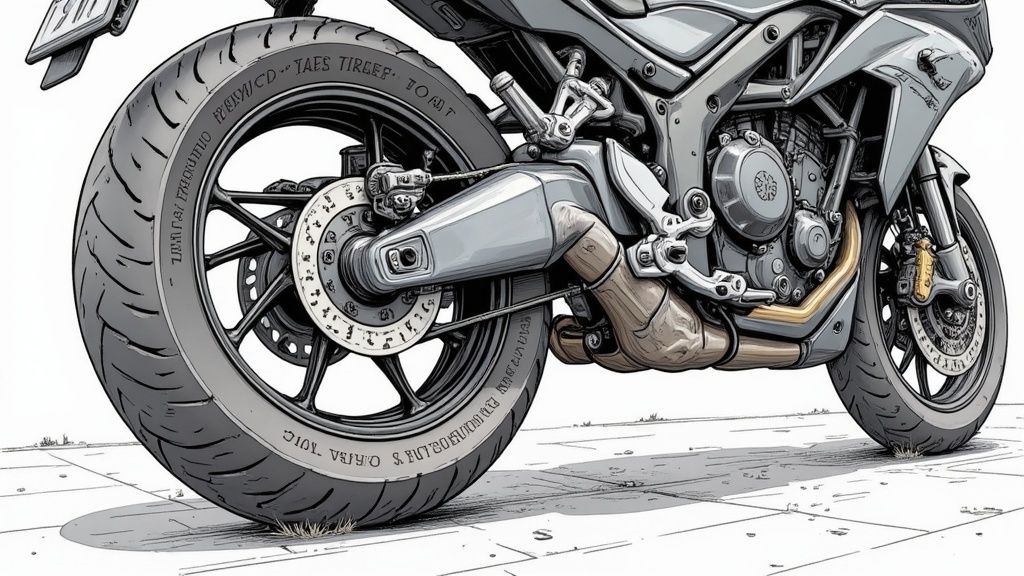
Just like your body needs proper hydration to function well, your motorcycle relies on specific fluids to keep running smoothly. Each fluid plays a vital role in your bike’s performance and longevity. Understanding how to properly manage these fluids is a fundamental skill that every rider should master, according to experienced mechanics and long-time motorcyclists.
Engine Oil: The Lifeblood of Your Engine
Think of engine oil as your motorcycle’s circulatory system. It moves through the engine, providing essential lubrication, cooling, and cleaning. Without regular oil changes, your engine faces serious risks like overheating and accelerated wear. Most bikes need fresh oil every 3,000-5,000 miles, but check your owner’s manual for the exact interval.
The type of oil you choose matters too. Traditional mineral oil works well and costs less, while synthetic oil handles extreme temperatures better and lasts longer between changes. For instance, if you ride in very hot summers or cold winters, spending extra on synthetic oil makes sense since it maintains proper viscosity in these conditions.
Brake Fluid: Ensuring Stopping Power
Your brakes are only as good as the fluid that powers them. Brake fluid transfers the force from your brake lever to the calipers, making it essential for stopping safely. Over time, this fluid absorbs moisture from the air, which can make your brakes feel soft and reduce their effectiveness. Many riders overlook this maintenance item, but changing brake fluid every 1-2 years helps prevent dangerous brake problems before they start.
Coolant: Maintaining Optimal Engine Temperature
Your engine needs to stay at the right temperature to work properly. Coolant, a mix of antifreeze and water, prevents both overheating and freezing damage. As coolant ages, it becomes less effective and can even turn corrosive, potentially damaging engine parts. Plan on replacing your coolant every two years to keep your engine running at the right temperature and protect it from internal damage.
Transmission and Final Drive Fluids: The Unsung Heroes
The fluids in your transmission and final drive might not get much attention, but they’re crucial for smooth shifting and power delivery. Each system needs specific lubricants to work correctly. For example, if you have a shaft-driven motorcycle, regular final drive oil changes keep the gears working smoothly and prevent wear. Checking your owner’s manual will tell you exactly what fluids to use and when to change them. Taking care of these often-forgotten fluids helps avoid expensive repairs down the road.
Professional Approaches to Tire Care
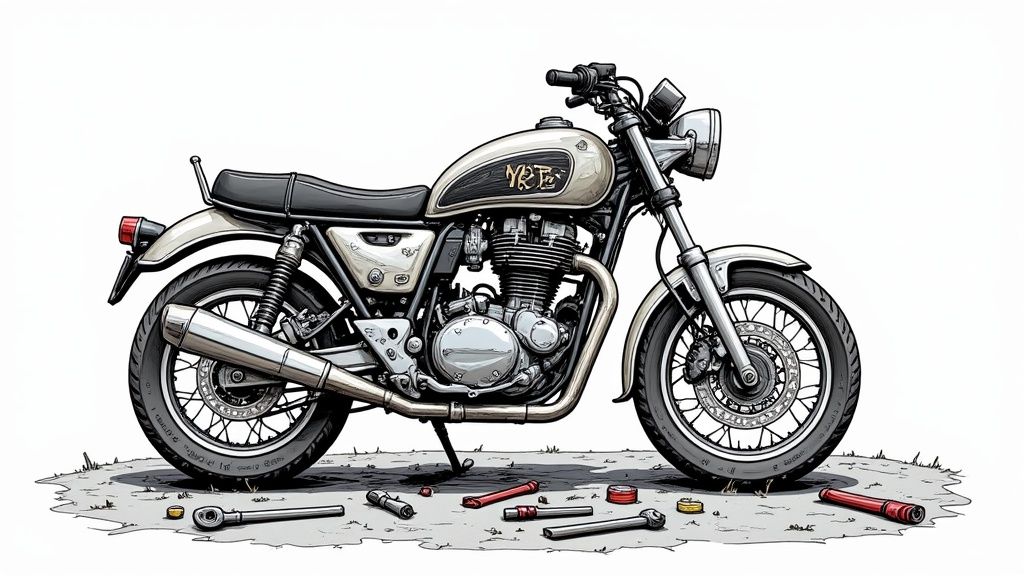
While proper fluid maintenance is essential for motorcycle performance, tire care demands equal attention. Your tires provide the only contact between your bike and the road, making them critical for handling, braking, and safety. Expert riders know that basic pressure checks alone aren’t enough - you need a complete approach that includes thorough inspection, regular maintenance, and smart replacement timing.
Advanced Tire Inspection Techniques
Checking tire pressure before rides is just the start. A professional inspection should look for:
- Cuts and Scrapes: Small cuts can seriously weaken tire structure and lead to blowouts. Take time to examine both sidewalls and tread surfaces for damage marks.
- Embedded Objects: Carefully check for and remove any nails, screws or debris stuck in the tire that could cause slow leaks or sudden flats. Get proper repairs when needed.
- Wear Patterns: Look for uneven wear across the tire surface. For instance, excessive center wear often means overinflation, while worn edges suggest underinflation. These patterns help diagnose alignment and suspension issues.
- Tread Depth: Use a proper gauge to measure remaining tread - most motorcycles need at least 2/32 inch depth for safe operation, especially in wet conditions. Replace tires before they reach minimum depth.
The Science Behind Proper Tire Maintenance
Getting the most from your tires requires understanding key factors that affect their performance:
- Inflation Pressure: Your owner’s manual specifies the right pressure for optimal contact, efficiency and tire life. Too little pressure creates excess heat and resistance, while too much reduces grip and ride quality.
- Riding Style: Hard acceleration and braking naturally wear tires faster. Match your tire choice to your riding habits - sport tires for aggressive riding, touring tires for distance.
- Weather Impact: Both hot and cold temperatures change tire pressure and grip. Wet roads demand better tread depth for safety.
- Storage Methods: Store bikes on stands to prevent flat spots, and keep tires away from direct sun and temperature extremes during off-season storage.
Extending Tire Life and Ensuring Safety
Use these proven strategies to maximize tire performance and longevity:
- Regular Rotation: Following your manual’s rotation schedule helps tires wear more evenly over time.
- Proper Cleaning: Remove road grime and contaminants with motorcycle-specific cleaners. Avoid harsh chemicals that could damage the rubber.
- Smart Replacement: Even with great maintenance, tires eventually need replacement. Don’t risk safety by running worn tires too long - replace them promptly when tread or performance degrades.
Making tire care a priority helps ensure your motorcycle performs at its best while keeping you safe on every ride. A systematic approach lets you catch problems early, optimize grip in all conditions, and make smart choices about tire selection and replacement timing. Remember that good tire maintenance isn’t just about longer tire life - it’s an investment in your safety and enjoyment on two wheels.
Drive System Excellence
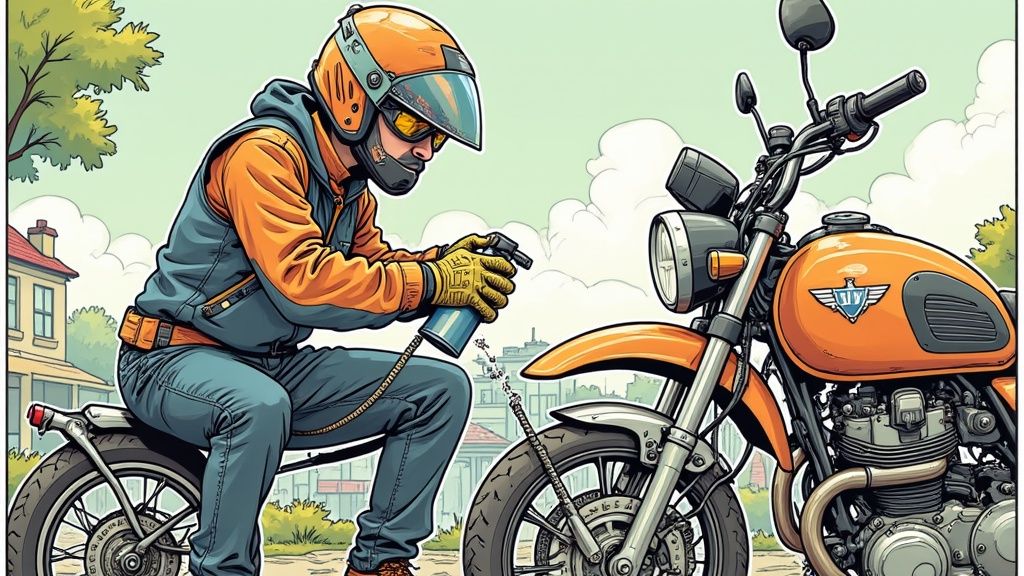
After ensuring proper tire care, the next essential area of motorcycle maintenance is the drive system. This critical component - made up of the chain, sprockets, or in some cases a shaft drive - transfers engine power to the rear wheel to move you forward. Taking good care of your drive system directly impacts performance, fuel economy, and most crucially, your safety on the road.
Chain and Sprocket Maintenance: A Deep Dive
For motorcycles with chain drive systems, proper maintenance is essential. With good care, a chain can last many thousands of miles, but neglect leads to early wear, power loss, and potential failure. The key elements of chain maintenance are:
- Cleaning: Road grime and dirt act like sandpaper on your chain, speeding up wear. Regular cleaning with motorcycle chain cleaner and a brush removes these damaging particles. While kerosene works well for cleaning, be mindful of proper disposal given environmental concerns. Stay away from harsh chemicals that could harm the chain’s O-rings.
- Lubrication: A well-lubricated chain reduces friction between parts, limiting wear on both chain and sprockets. Choose a quality motorcycle-specific chain lubricant and apply it evenly after cleaning, focusing on the inner rollers where it’s most needed.
- Adjustment: Chain tension matters - too loose and it can whip or jump off, too tight and it strains the engine and other parts. Check your owner’s manual for the right amount of slack and adjust the rear axle position as needed to achieve proper tension.
Recognizing Wear and Tear
Knowing when drive components need replacement helps prevent expensive repairs down the road. Watch for these warning signs:
- Tight Spots: When rotating the rear wheel by hand, any stiff or binding spots in the chain indicate wear.
- Worn Sprocket Teeth: Healthy sprocket teeth have even, symmetrical profiles. Hook-shaped or pointed teeth mean it’s time for new sprockets. For best results, replace both front and rear sprockets together when installing a new chain.
- Excessive Chain Stretch: Despite regular adjustments, chains eventually stretch beyond usable limits. Replace the chain if it exceeds the length specifications in your manual.
Shaft Drive Systems: The Low-Maintenance Alternative
While chain drives need frequent attention, shaft drive systems typically require less upkeep. These sealed units only need fluid changes every 12,000-18,000 miles, depending on your motorcycle model. However, they still need some care - check regularly for leaks and proper fluid levels. A small leak left unchecked can lead to complete drive failure and major repair costs. Keep an eye on fluid color and consistency, watching for contamination or metal particles that signal problems.
By understanding how your motorcycle’s drive system works and following these maintenance practices, you’ll enjoy smooth operation and longer component life while avoiding unnecessary repairs. This kind of preventive care not only saves money but also makes every ride more enjoyable and worry-free.
Advanced Brake System Care
Your motorcycle’s brake system is fundamentally important for safety. Good brake maintenance involves much more than basic fluid checks - it requires understanding how your brakes work and following professional maintenance practices.
Professional-Grade Brake Inspection Techniques
Strong brake maintenance starts with thorough visual inspections. Begin by carefully checking brake lines for cracks, bulges, or leaks that could compromise safety. Next, examine the brake calipers - they should move freely without sticking. For example, if a caliper binds, it can cause uneven brake pad wear and potentially dangerous pulling to one side during braking. Taking time to inspect these components properly helps prevent serious issues.
The Truth About Brake Fluid Maintenance
Brake fluid naturally absorbs moisture from the air over time, which lowers its boiling point and increases the risk of brake fade during heavy use. While most riders stay on top of engine oil changes, brake fluid often gets neglected. Following manufacturer guidelines, you should flush and replace brake fluid every 1-2 years to maintain reliable braking performance. This simple step makes a big difference in brake system longevity.
Mastering Brake Pad Assessment
Brake pads directly impact your stopping power, making regular pad checks essential. Most pads include wear indicators that make noise when replacement is needed. Don’t wait for that warning - check pad thickness frequently and look for signs of uneven wear. Think of brake pads like shoe soles - uneven wear patterns can point to alignment or caliper issues that need fixing. Catching these problems early helps maintain stable, predictable braking.
Impact of Riding Styles on Brake Wear
How you ride affects brake component lifespan. Frequent hard braking generates more heat and stress throughout the system. For instance, a rider who makes lots of aggressive stops in city traffic will need more frequent pad and rotor replacements compared to someone who mainly cruises highways. Understanding your riding habits helps you set appropriate maintenance intervals.
Maintaining Consistent Braking Power: Proven Techniques
Reliable braking requires ongoing care beyond basic maintenance. New brake pads need proper bedding-in through controlled stops at moderate speeds to mate correctly with the rotors. Regular cleaning with quality brake cleaner removes performance-robbing contamination. These straightforward practices, combined with routine inspections and fluid service, help ensure your brakes work dependably when you need them most.
Professional Cleaning and Protection Strategies
Just as mechanical upkeep is vital for your motorcycle’s performance, proper cleaning and protection are essential for its long-term condition. A clean and well-protected bike not only looks great but also fights off corrosion, safeguards critical components, and maintains its value over time. Let’s explore professional-grade methods that go beyond basic washing to keep your motorcycle in pristine condition.
Advanced Cleaning Techniques That Preserve Finish Quality
Professional cleaning requires a gentle touch to protect your motorcycle’s delicate surfaces. Expert detailers select pH-neutral motorcycle soaps that effectively remove dirt without damaging the protective wax or paint layers. For instance, they rely on premium microfiber cloths and wash mitts that safely trap contaminants rather than grinding them into the finish. This careful approach prevents common issues like swirl marks and scratches that can mar your bike’s appearance.
Protective Measures That Actually Work
The right protective products act like an invisible shield for your motorcycle. Professional-grade sealants and coatings are specifically formulated to defend against UV rays, rain, and road debris that can cause paint fading and surface deterioration. This protection is particularly important for motorcycles exposed to extreme weather conditions. After waxing, applying a quality paint sealant creates an extra barrier that extends the life of the protective coating.
Professional Secrets for Maintaining Showroom Condition
Detail experts employ specialized tools and methods to achieve superior results. They use purpose-made brushes to clean confined spaces around engines, wheels, and brake components without causing scratches. Another professional technique involves using compressed air for drying, which prevents water spots and ensures a flawless finish. These meticulous methods distinguish expert detailing from basic cleaning.
Protecting Sensitive Electronics During Cleaning
Today’s motorcycles feature sophisticated electronic systems that need special protection during washing. Professional detailers take extra precautions around electrical connections and displays. Before cleaning, they cover sensitive components with waterproof materials to prevent moisture damage. This careful preparation helps maintain the reliability of your bike’s electronic systems.
Mastering The Art Of Corrosion Prevention
Fighting corrosion requires ongoing attention and the right preventive measures. Professional mechanics regularly apply corrosion inhibitors to metal surfaces, focusing on areas prone to rust like frame components, exhaust systems, and hardware. These protective treatments create an effective barrier against moisture and corrosive elements, helping extend the life of metal parts.
Developing a Sustainable Maintenance Routine
Regular professional cleaning and protection should be as routine as mechanical maintenance. While daily detailed cleaning isn’t necessary, following a consistent schedule for cleaning and applying protective products will significantly impact your motorcycle’s condition and value. Making these practices part of your regular maintenance helps ensure long-lasting results.
Just as you track mechanical services, keeping detailed records of cleaning and protection work demonstrates professional-level care. Auto Service Logger provides a complete system for documenting all maintenance activities, from routine service to detailing work. This organized approach helps ensure your motorcycle receives proper care on a consistent schedule. With thorough documentation, you can maintain optimal cleaning and protection practices for your bike.